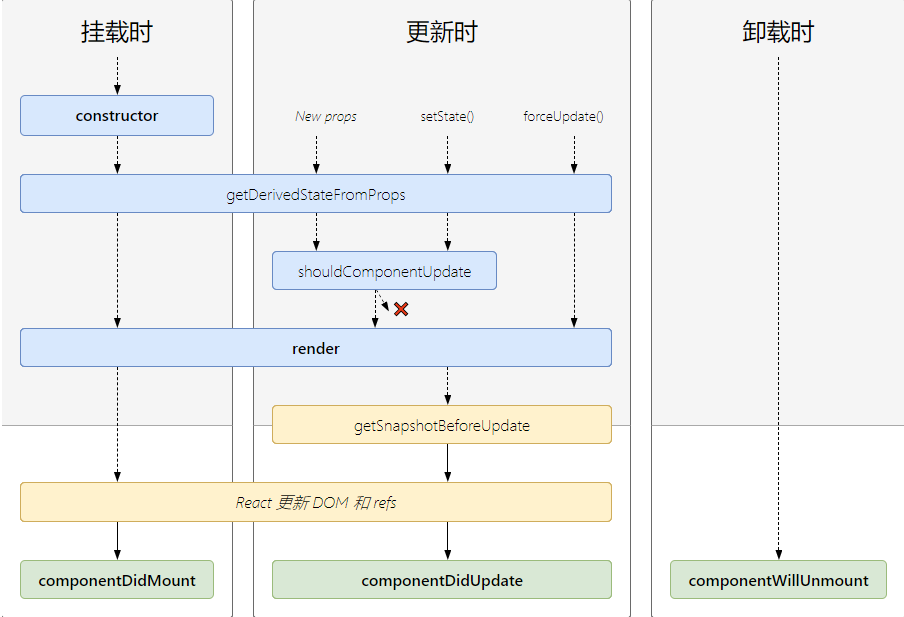[TOC]
React 16版本有一个名为 Fiber 的新核心架构。
# 事件机制
# setState
# `React.lazy` 与 `React.Suspense`
> `React.lazy`和 Suspense 技术还不支持服务端渲染。如果你想要在使用服务端渲染的应用中使用,我们推荐[Loadable Components](https://github.com/gregberge/loadable-components)这个库。它有一个很棒的[服务端渲染打包指南](https://loadable-components.com/docs/server-side-rendering/)。
> `React.lazy`目前只支持默认导出(default exports)
`React.Suspense`也是一种虚拟组件(类似于[Fragment](https://reactjs.org/docs/react-api.html#reactfragment),仅用作类型标识),用法如下:
```
import { BrowserRouter as Router, Route, Switch, Link } from 'react-router-dom';
import React, { Suspense, lazy } from 'react';
const Home = lazy(() => import('./Home'));
const Bar = lazy(() => import('./Bar'));
const App = () => (
<Router>
<Suspense fallback={<div>loading</div>}>
<div>
<ul>
<li><Link to="/">Home></Link></li>
<li><Link to="/bar">Bar></Link></li>
</ul>
</div>
<Switch>
<Route exact path="/" component={Home} />
<Route path="/bar" component={Bar} />
</Switch>
</Suspense>
</Router>
)
export default App;
```
`Suspense`子树中只要存在还没回来的 Lazy 组件,就走`fallback`指定的内容。**这不正是可以提升到任意祖先级的loading吗?**
http://www.ayqy.net/blog/react-suspense/
# React Context
React的 context 就是一个全局变量,可以从根组件跨级别在 React 的组件中传递。React context 的API有两个版本,React16.x 之前的是 老版本的 context,之后的是新版本的 context。
新版本的 React context 使用了`Provider`和`Customer`模式,和 react-redux 的模式非常像。在顶层的`Provider`中传入`value`,
在子孙级的`Consumer`中获取该值,并且能够传递函数,用来修改 context,如下代码所示:
```
import React, { createContext } from 'react';
// 创建Context的唯一方法
const ThemeContext = createContext()
const SizeContext = createContext()
class App extends React.Component {
state = {
theme: 'red',
size: 'small'
}
render () {
const { theme, size } = this.state
return (
// 使用 Context.Provider 包裹后续组件,value 指定值
<ThemeContext.Provider value={theme}>
{/* 当出现多个Context的时候,只需要将Context.Provider 嵌套即可 */}
<SizeContext.Provider value={size}>
{/* 当Context的Provider值更改时,Consumer 的值必须重新渲染 */}
<button onClick={() => {this.setState({ theme: 'yellow', size: 'big'})}}>按钮</button>
<Middle></Middle>
</SizeContext.Provider>
</ThemeContext.Provider>
)
}
}
class Bottom extends React.Component {
render () {
return (
// Context.Consumer Consumer 消费者使用 Context 得值
// 但子组件不能是其他组件,必须渲染一个函数,函数的参数就是 Context 得值
// 当出现 多个 Consumer 的时候,进行嵌套,每个 Consumer 的子组件必须是一个函数,即可
<ThemeContext.Consumer>
{
theme => (
<SizeContext.Consumer>
{
size => (<h1>ThemeContext 的 值为 {theme}; SizeContext 的值为 {size}</h1>)
}
</SizeContext.Consumer>
)
}
</ThemeContext.Consumer>
)
}
}
class Middle extends React.Component {
render () {
return <Bottom></Bottom>
}
}
export default App;
```
* 当 Provider 提供的值更改时,Consumer 必须重新渲染
* context 不仅仅只是可以传数值,也可以传函数。
* 创建 Context 的时候`createContext`可以传入默认值,当向上找不到 Provider 的时候,就会显示默认值
> 注意:context 类似于全局变量做法,会让组件失去独立性、复用起来更困难,不能滥用、但本身它一定有适合使用的场景,具体看情况使用
## contextType
React 16.6 引入了在不直接使用 Consumer 组件的情况下从上下文消费数据的功能。这有助于减少组件 JSX 中不必要的嵌套,使它们更易于阅读。
```
import React, { createContext } from 'react';
// 创建Context的唯一方法
const ThemeContext = createContext()
const SizeContext = createContext()
class App extends React.Component {
state = {
theme: 'red',
size: 'small'
}
render () {
const { theme, size } = this.state
return (
// 使用 Context.Provider 包裹后续组件,value 指定值
<ThemeContext.Provider value={theme}>
{/* 当出现多个Context的时候,只需要将Context.Provider 嵌套即可 */}
<SizeContext.Provider value={size}>
{/* 当Context的Provider值更改时,Consumer 的值必须重新渲染 */}
<button onClick={() => {this.setState({ theme: 'yellow', size: 'big'})}}>按钮</button>
<Middle></Middle>
</SizeContext.Provider>
</ThemeContext.Provider>
)
}
}
class Bottom extends React.Component {
// 申明静态变量、contextType 将 context 直接赋值于 contextType
static contextType = ThemeContext
render () {
// 在 render 函数中 可以直接 访问 this.context 获取共享变量、这样就可以不使用 consumer
const theme = this.context
return (
// Context.Consumer Consumer消费者使用Context得值
// 但子组件不能是其他组件,必须渲染一个函数,函数的参数就是Context得值
// 当出现 多个Consumer的时候,进行嵌套,每个Consumer 的子组件必须是一个函数,即可
<div>
<h1>ThemeContext 的 值为 {theme} </h1>
</div>
)
}
}
class Middle extends React.Component {
render () {
return <Bottom></Bottom>
}
}
export default App;
```
* `contextType`只能在类组件中使用
* 一个组件如果有多个consumer, contextType 只对其中一个有效,所以说,`contextType`只能有一个
## React context的局限性
1. 在组件树中,如果中间某一个组件 `ShouldComponentUpdate` `returning false` 了,会阻碍 context 的正常传值,导致子组件无法获取更新。
2. 组件本身 extends `React.PureComponent` 也会阻碍 context 的更新。
注意点:
1. Context 应该是唯一不可变的
2. 组件只在初始化的时候去获取 Context
> [context.html#classcontexttype](https://reactjs.org/docs/context.html#classcontexttype)
> [React context基本用法](https://www.cnblogs.com/mengff/p/9511419.html)
# 新的生命周期
需要关注新的[声明周期](https://zh-hans.reactjs.org/docs/react-component.html):

目前在 16.4 版本中:
* ~~componentWillMount~~,
* ~~componentWillReceiveProps~~,
* ~~componentWillUpdate~~
并未完全删除这三个生命周期函数,而且新增了
* `UNSAFE_componentWillMount`,
* `UNSAFE_componentWillReceiveProps`,
* `UNSAFE_componentWillUpdate`
三个函数,官方计划在 17 版本完全删除这三个函数,只保留 `UNSAVE_` 前缀的三个函数,目的是为了向下兼容,但是对于开发者而言应该尽量避免使用他们,而是使用新增的生命周期函数替代它们
**取而代之的生命周期**
1. [static getDerivedStateFromProps(nextProps, prevState)](https://zh-hans.reactjs.org/docs/react-component.html#static-getderivedstatefromprops)
2. [getSnapshotBeforeUpdate(prevProps, prevState)](https://zh-hans.reactjs.org/docs/react-component.html#getsnapshotbeforeupdate)
## `getDerivedStateFromProps`
当我们接收到新的`props`,想去修改我们state,可以使用`getDerivedStateFromProps`。
```
class ExampleComponent extends React.Component {
state = {
isScrollingDown: false,
lastRow: null
}
static getDerivedStateFromProps(nextProps,prevState){
if(nextProps.currentRow !== prevState.lastRow){
return {
isScrollingDown:
nextProps.currentRow > prevState.lastRow,
lastRow: nextProps.currentRow
}
}
return null;
}
}
```
## `getSnapshotBeforeUpdate`
这个函数有一个返回值,会作为第三个参数传给 `componentDidUpdate`,如果你不想要返回值,请返回 `null`,不写的话控制台会有警告
```
class ScrollingList extends React.Component {
constructor(props) {
super(props);
this.listRef = React.createRef();
}
getSnapshotBeforeUpdate(prevProps, prevState) { //表示之前的props 和之前的 state
// Are we adding new items to the list?
// Capture the scroll position so we can adjust scroll later.
if (prevProps.list.length < this.props.list.length) {
const list = this.listRef.current;
return list.scrollHeight - list.scrollTop;
}
return null;
}
componentDidUpdate(prevProps, prevState, snapshot) {
// If we have a snapshot value, we've just added new items.
// Adjust scroll so these new items don't push the old ones out of view.
// (snapshot here is the value returned from getSnapshotBeforeUpdate)
if (snapshot !== null) {
const list = this.listRef.current;
list.scrollTop = list.scrollHeight - snapshot;
}
}
render() {
return (
<div ref={this.listRef}>{/* ...contents... */}</div>
);
}
}
```
## `componentDidUpdate(prevProps, prevState, snapshot)`
该方法在`getSnapshotBeforeUpdate`方法之后被调用,有三个参数`prevProps,prevState,snapshot`,**表示之前的props,之前的state,和snapshot**。第三个参数是`getSnapshotBeforeUpdate`返回的。
## 参考
[生命周期图](http://projects.wojtekmaj.pl/react-lifecycle-methods-diagram/)
[官网 - 组件的生命周期](https://zh-hans.reactjs.org/docs/react-component.html#the-component-lifecycle)
[[译]如何使用React生命周期方法](https://juejin.im/post/5b59d1c8e51d4519455846e0)
[React 16.6.X版本的更新功能](https://www.jianshu.com/p/406bcc058790)
[盘点 React 16.0 ~ 16.5 主要更新及其应用](https://www.cnblogs.com/sunshq/p/10430728.html)
